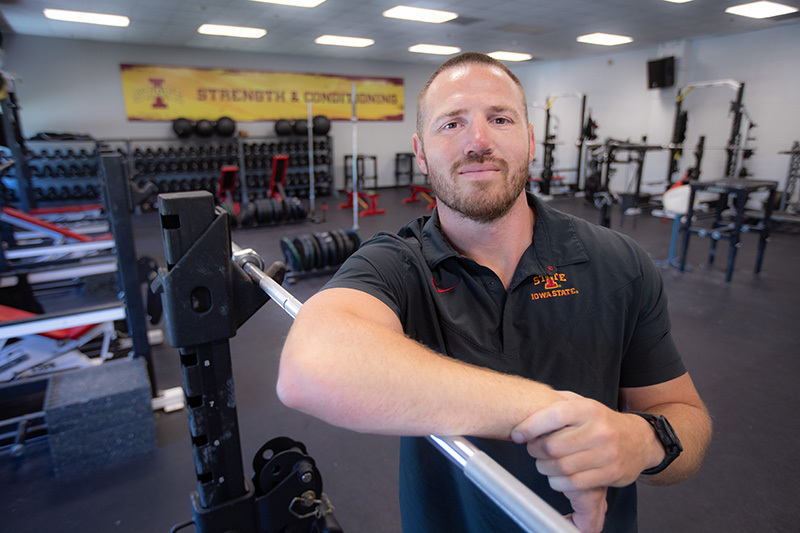
Ben Durbin is in his sixth season as Olympic sports strength and conditioning coach. Durbin’s primary sports are wrestling, gymnastics, men’s and women’s cross country, and track and field middle distance. Photo by Chris Gannon.
It was quite an end to the season in several Olympic sports at Iowa State. The wrestling team had its best finish at the national tournament since 2010. The men's track and field team earned its best outdoor nationals point total since 1996 while the women had their strongest showing since 2017. Under the direction of a first-year head coach, the gymnastics squad enjoyed a 15-spot improvement in the national rankings over last year, marking the largest turnaround in program history.
Ben Durbin
Years at ISU: 6
Postiion: Olympic sports strength and conditioning coach
Education: Bachelor's in psychology from the University of Wyoming; master's in higher education at Iowa State; Certified Strength and Conditioning Specialist; Registered Strength and Conditioning Coach; and USA weightlifting certified
Ben Durbin, a former football player at the University of Wyoming and Iowa State, played a part in all those strong showings. The Olympic sports strength and conditioning coach focuses on wrestling, gymnastics, cross country, and track and field middle distance student athletes. He talked with Inside about his work, how he tries to aid athletes and what experience has taught him.
Campus gets quieter during the summer. Is that the case for you?
Different sports have different training cycles during the summer to get them quality development when their other demands are a little less. We can really intensify their bodily development. Depending on the demands of the sport, student athletes could be lifting two to four times a week. Some athletes may be with me every day for an hour or two and others maybe just a couple times a week.
For some athletes, we want to get them stronger but without the undesired muscle mass gain; others, we want to get them stronger and bigger. I can be working with athletes throughout the day but try to schedule as many in the morning as possible so they can be college kids and enjoy their summer.
You are the connection to the program for the athletes during the summer. How do you maximize that relationship?
I look to build confidence because it is such a big component. It's all about what building consistency, discipline and strategy can do for them. If we build that in the offseason, hopefully that carries on when they get into their sports schedules.
I have learned being yourself with the athletes is important. When I first started, I had a military mindset with the athletes: I am the coach and you are the athlete. I wasn’t getting much buy-in. When I started just being myself and earning their trust that way, I quickly realized you can't be someone you're not.
How do you know what each athlete needs?
Each of the about 100 athletes I work with has a personalized program I develop based on a strength profile. Their strength levels, skill set and prior exposures dictate what their training regimen looks like with me. I find their absolute strength, speed and power output in a variety of different movement patterns, and I use that to more accurately develop their training. It's a year-round process that's always changing. As I get feedback from the athlete, there are changes in schedules and changes in their strength sets.
How has technology changed the work you do?
We want to maximize power output while minimizing fatigue. We want to target just enough intensity so we are getting stimulus and growth, but not having a detrimental effect on their effort in subsequent days or weeks. We have technology that sees asymmetries in strength capacity from the right to left leg. We can monitor bar speed based on any load that is on the athlete, we can monitor grip strength. A software system monitors all our practice and weightlifting time. Any technology that's available in the strength and conditioning world now, we have it.
Where do you believe this training made a significant impact in the sports you oversee?
One that sticks out is the cross country teams. A lot of times you have cross country athletes who have no prior exposure to strength and conditioning. Getting them excited about the weight room and seeing how strength levels there translate to three to five miles has been a process. The men's team had a second- and fifth-place finish at nationals and the women achieved two top-25 finishes.
